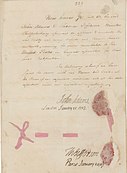Moroccan–American Treaty of Friendship
In December 1777, the Moroccan Sultan Muhammad III included the United States in a list of countries to which Morocco’s ports were open. Morocco thus became the first country whose head of state publicly recognized the newly independent United States.[1] Relations were formalized with the Moroccan–American Treaty of Friendship (also known as the Treaty of Marrakesh) negotiated by Thomas Barclay in Marrakesh, and signed by American diplomats in Europe, Thomas Jefferson, John Adams with Sultan Muhammad III in 1786.[2][3]
Moroccan–American Treaty of Friendship (Treaty of Marrakesh), 1786-1787 | |
| Signed | 28 June 1786, 15 July 1786 |
|---|---|
| Location | Marrakesh, Morocco |
| Original signatories | Morocco United States |
History
Muhammad III, or Sidi Muhammad ibn Abdallah, came to power in 1757 and ruled until his death in 1790. Prior to his reign, Morocco had experienced 30 years of internecine battles, instability and turmoil. During the 33 years Sidi Muhammad ruled he transformed the politics, the economy and the society, putting development of international trade high on his agenda and restoring power to the sultanate. This served to quickly bring respect to Morocco on the international scene.[4] Central to his pursuit of international trade was the negotiation of agreements with foreign commercial powers. He began seeking one with the United States before the war with Great Britain was settled in 1783, and welcomed Thomas Barclay's arrival to negotiate in 1786. The treaty signed by Barclay and the sultan, then by Jefferson and Adams, was ratified by the Confederation Congress in July 1787.[5] It was reaffirmed by the sultan in 1803 when the USS Constitution, Nautilus, New York, and Adams engaged in gunboat diplomacy as part of the First Barbary War. (At the time, independent corsairs and pirates were using Morocco's ports as safe harbors between raids on American and European shipping.) The treaty has withstood transatlantic stresses and strains for more than 232 years, making it the longest unbroken treaty relationship in United States history.[6]
References
- Roberts, Priscilla H.; Tull, James N. (June 1999). "Moroccan Sultan Sidi Muhammad Ibn Abdallah's Diplomatic Initiatives toward the United States, 1777-1786". Proceedings of the American Philosophical Society. 143 (2): 233–265. JSTOR 3181936.
- Roberts, Priscilla H. and Richard S. Roberts, Thomas Barclay (1728–1793): Consul in France, Diplomat in Barbary. Lehigh University Press. 2008, pp.158–223. ISBN 978-0-934223-98-0.
- "US-Morocco: Longstanding Ties (Remarks by President Bush and King Hassan II); U.S. Department of State Dispatch". January 24, 2007.
- B.A. Ogot, General History of Africa, Vol. V: Africa from the 16th to the 18th Century. Berkeley: University of California Press, 1992. pp. 231–232.
- Roberts, Thomas Barclay (1728–1793)..., pp.195–223
- Ogot, General History of Africa, pp. 231–232.
External links
- English text of the treaty from Yale's Lillian Goldman Law Library
- History of The Moroccan-American Treaty of Friendship and Moroccan-American Relations
- Historical Background
- Morocco-US relations, Embassy of the Kingdom of Morocco
- Moroccan – U.S. Relations, 1750 – 1912
![]()

